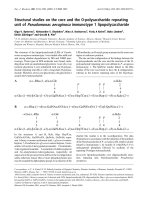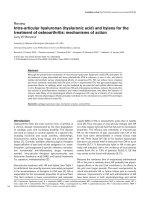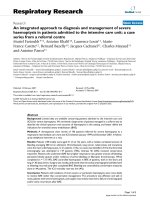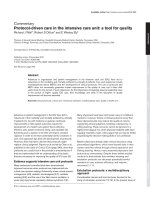Báo cáo y học: " Paediatric intensive care: the why and how for trainees" pdf
Bạn đang xem bản rút gọn của tài liệu. Xem và tải ngay bản đầy đủ của tài liệu tại đây (80.81 KB, 1 trang )
Available online />Ask any trainee, there is a very steep learning curve during
the first 6 months of a new job in critical care. If they are
good (and their unit is any good), the trainees will have
acquired a number of protocols and clinical recipes within a
matter of weeks. But that is not the point — certainly not from
my perspective as their educational supervisor. What I wish
to see is evidence of thought, a drawing together of the basic
principles and understanding of pathophysiology, and a
creative application to real clinical problems.
Surprisingly, I found Gale Pearson’s Handbook of Paediatric
Intensive Care an enjoyable read. I had expected to find yet
another small book of unreadable lists and protocols. Instead,
what I discovered was a text that provoked reflection about
why we do what we do in paediatric critical care. This is
consequently not a pocketbook that can be easily used at the
bedside. Rather, this handbook is something that should be
consumed during that coffee break, after the action. But that
said, I highly recommend it as a starting point for all trainees
working on paediatric intensive care units.
This book has 20 chapters, numerous illustrative figures, and
user-friendly tables and fact-boxes. There is a good 7-page
introduction for the new trainee, instructing them on who
comes to work on a paediatric unit, and providing tips before
starting work. The chapter on audit and scoring systems is
also palatable. The rest of the chapters cover each organ
system, with subsections devoted to common clinical
problems and derangements encountered within that system,
their underlying pathophysiology, and the rationale for
treatment or support intervention. Certainly, there are some
omissions. But it is a small book, and most supervisors will
pick these omissions up. For example, there is no mention of
withdrawal syndrome and the now frequent use of clonidine
in paediatric practice in the section on sedatives and
analgesics. Also, there is no cautionary statement about the
use of propofol. These, however, are minor points. What I
really like about this book is its organisation and potential as
an educational aid. In fact, it could very easily be used as a
curriculum guide.
In the United Kingdom, trainees working in paediatric
anaesthesia, acute paediatrics, and paediatric critical care
can spend 3 or 6 months, or 1 or 2 years assigned to a
regional training unit. It is to Gale Pearson’s credit that this
book could also form the basis or structure for a learner’s
portfolio. The supervisor could easily select from the chapters
an educational plan for the 3-month and 6-month residents;
their goals, how to achieve them, and the evidence that will
be needed to support a claim of completion. That is certainly
what I shall be doing now that I have a copy, albeit acquired
by serendipity.
Competing interests
None declared.
Book report
Paediatric intensive care: the why and how for trainees
Robert C Tasker
Consultant University Lecturer in Paediatrics and Intensive Care Medicine, and Director of Medical Education in
Paediatrics, University of Cambridge School of Clinical Medicine, Cambridge, UK
Correspondence: Robert C Tasker,
Published online: 25 April 2002
Critical Care 2002, 6:275
© 2002 BioMed Central Ltd (Print ISSN 1364-8535; Online ISSN 1466-609X)
Keywords child, critical care, intensive care, therapeutics
Pearson GA: Handbook of Paediatric Intensive Care. London: W.B. Saunders, Harcourt Publishers Limited,
2002. 336 pp. ISBN 0-70-202346-9 (pbk).









